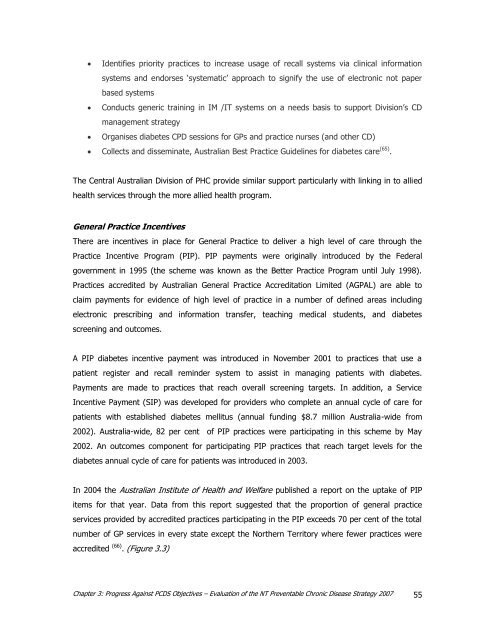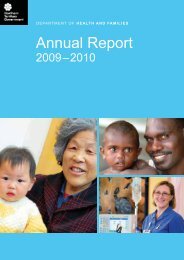PCD Strategy Evaluation 2007.pdf - NT Health Digital Library ...
PCD Strategy Evaluation 2007.pdf - NT Health Digital Library ...
PCD Strategy Evaluation 2007.pdf - NT Health Digital Library ...
You also want an ePaper? Increase the reach of your titles
YUMPU automatically turns print PDFs into web optimized ePapers that Google loves.
Identifies priority practices to increase usage of recall systems via clinical informationsystems and endorses „systematic‟ approach to signify the use of electronic not paperbased systems Conducts generic training in IM /IT systems on a needs basis to support Division‟s CDmanagement strategy Organises diabetes CPD sessions for GPs and practice nurses (and other CD) Collects and disseminate, Australian Best Practice Guidelines for diabetes care (65) .The Central Australian Division of PHC provide similar support particularly with linking in to alliedhealth services through the more allied health program.General Practice IncentivesThere are incentives in place for General Practice to deliver a high level of care through thePractice Incentive Program (PIP). PIP payments were originally introduced by the Federalgovernment in 1995 (the scheme was known as the Better Practice Program until July 1998).Practices accredited by Australian General Practice Accreditation Limited (AGPAL) are able toclaim payments for evidence of high level of practice in a number of defined areas includingelectronic prescribing and information transfer, teaching medical students, and diabetesscreening and outcomes.A PIP diabetes incentive payment was introduced in November 2001 to practices that use apatient register and recall reminder system to assist in managing patients with diabetes.Payments are made to practices that reach overall screening targets. In addition, a ServiceIncentive Payment (SIP) was developed for providers who complete an annual cycle of care forpatients with established diabetes mellitus (annual funding $8.7 million Australia-wide from2002). Australia-wide, 82 per cent of PIP practices were participating in this scheme by May2002. An outcomes component for participating PIP practices that reach target levels for thediabetes annual cycle of care for patients was introduced in 2003.In 2004 the Australian Institute of <strong>Health</strong> and Welfare published a report on the uptake of PIPitems for that year. Data from this report suggested that the proportion of general practiceservices provided by accredited practices participating in the PIP exceeds 70 per cent of the totalnumber of GP services in every state except the Northern Territory where fewer practices wereaccredited (66) . (Figure 3.3)Chapter 3: Progress Against <strong>PCD</strong>S Objectives – <strong>Evaluation</strong> of the <strong>NT</strong> Preventable Chronic Disease <strong>Strategy</strong> 2007 55
















